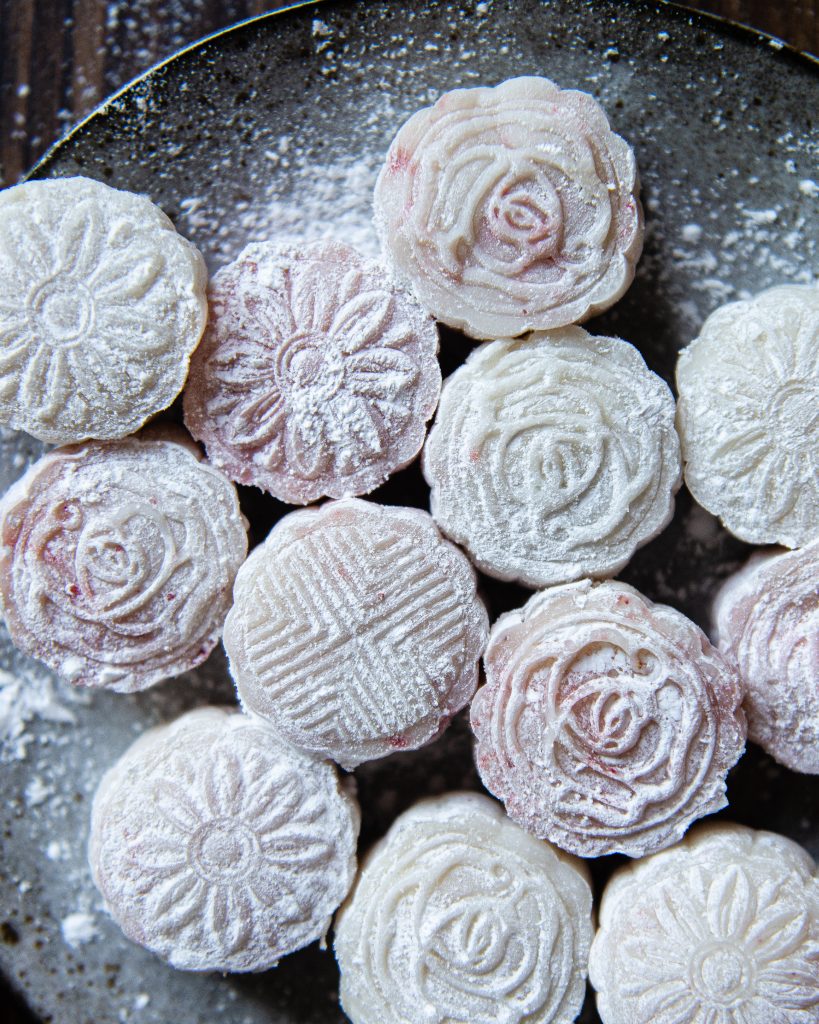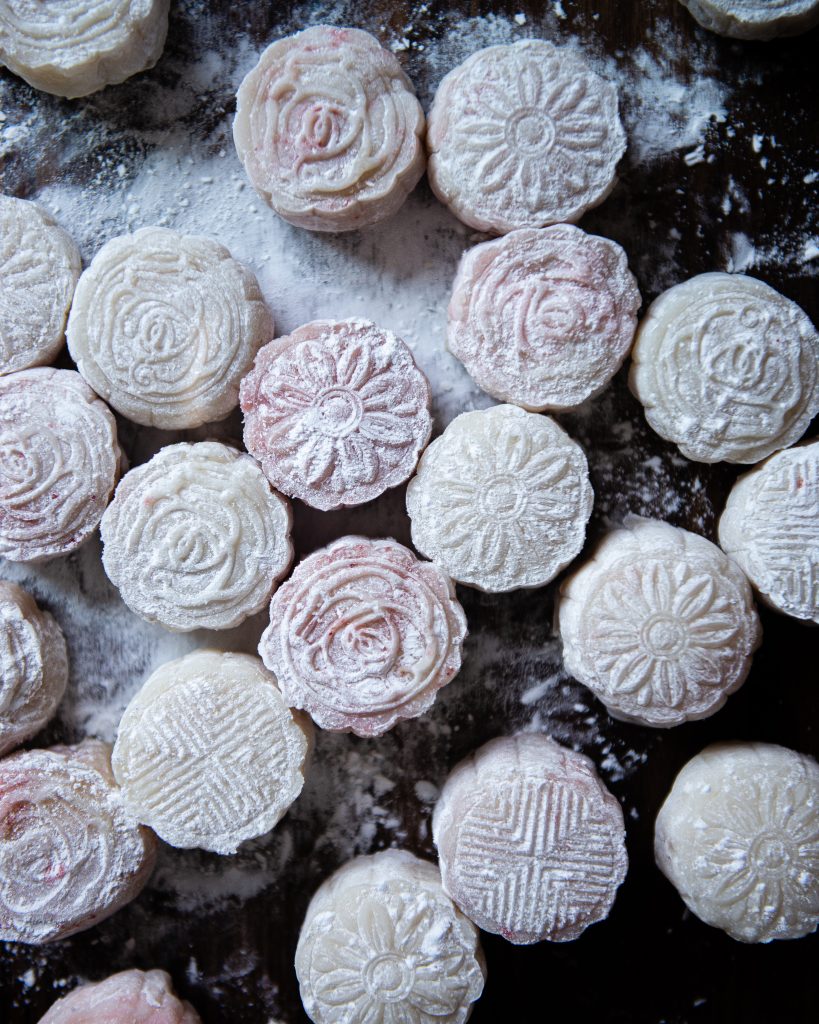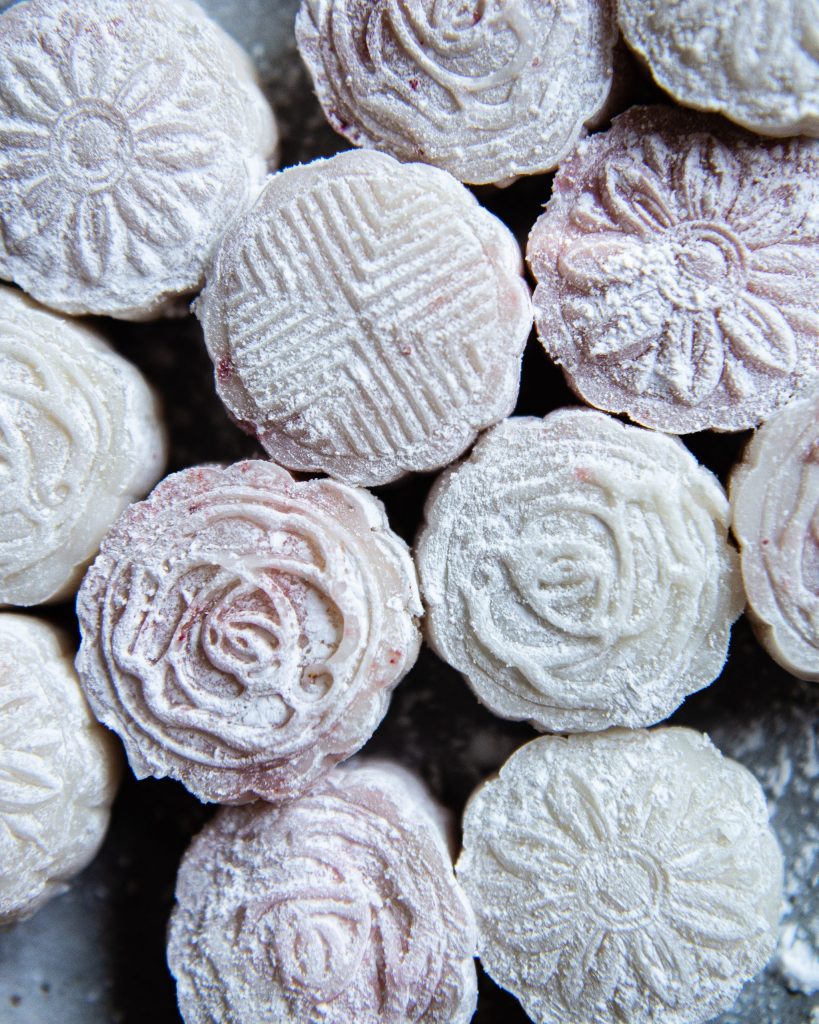rose & lychee snowskin mooncakes
I hadn’t intended to post a recipe for Mid-Autumn Festival this year, but these rose and lychee snowskin mooncakes were such a hit with our little family that I thought I’d share them here with you, even if last-minute. Unlike the traditional sort, burnished golden with lye water and baked, snowskin mooncakes are wrapped in a soft, mochi-like dough, often served chilled, and filled with anything you please, from chocolate ganache to custard to ice cream. Nothing will replace lotus paste and salted yolk in my heart (and we have a few of those ready to go for tomorrow), but the snappy, cool texture of these, with rosewater and a hint of raspberry in the wrapper, smooth lychee-flavored white bean paste for filling, and pieces of bright, floral lychee in the center, is hard to beat.
I made these snowy mooncakes on a whim this week after thinking fondly of this rose mochi from many years ago, and after I’d found a few of the storebought stuffed mochi we’d tried slightly lacking. A “whim,” in this new family of five, turns out to be having an idea a week ago then spending four days doing a very little bit at a time and at least two moments when you wonder why you ever wanted to do this, so this recipe is coming on the very eve of Mid-Autumn Festival. On the bright side, that means there are plenty of notes below on how to break up this recipe, which can otherwise be a bit involved, over several days. I happen to think that these would be great any time of year (they are, after all, pretty much chapssaltteok, and on top of that, naturally vegan and gluten-free) but should you feel ambitious, it’s also possible to hustle and make these over the course of tomorrow, and enjoy them just in time for Mid-Autumn Festival. I’ve added notes below on that, too.
Happy Mid-Autumn and Chuseok to everyone celebrating.



rose & lychee snowskin mooncakes
These snowskin mooncakes are a twist on the traditional mooncake that are more like daifuku or chapssaltteok. They have a delicate, rose-flavored mochi wrapper, based on this recipe by Amy Ho of Constellation Inspiration, with a smooth white bean-lychee paste (shiroan) filling adapted from this recipe by Namiko Chen of Just One Cookbook, and are stuffed with pieces of lychee. They’re one of my favorite things in recent memory. The white bean paste is mild, smooth, and the perfect canvas for sweet lychee, and the bright floral hints in the lychee go hand-in-hand with the rosewater in the wrapper.
The recipe below is written to make these over the course of several days, but see Notes on thoughts on how to make them faster.
Ingredients
For the lychee-white bean paste filling:
- 7 ounces dried lima beans or white beans of your choice
- 1 ¼ cup syrup from canned lychee (see Notes if using fresh)
- ¼ teaspoon kosher salt
For the mooncake wrapper:
- ¾ cup (180 grams) unsweetened full-fat coconut milk
- 1 tablespoon vegetable oil (1 tablespoon)
- 1–2 teaspoons rosewater
- ⅓ cup packed (50 grams) powdered sugar
- ⅓ cup (50 grams) sweet rice flour (also labeled mochiko or glutinous rice flour)
- ¼ cup (35 grams) rice flour
- 3 tablespoons (20 grams) tapioca flour
- ¼ cup strawberry or raspberry powder (optional; see Notes)
To assemble:
- 8–10 pieces canned lychee, from above (see Notes if using fresh)
- Tapioca flour, for dusting
Instructions
- At least a day or up to 3-4 days ahead, for the filling: Rinse the white beans well and place in a large bowl with plenty of water overnight (8 to 12 hours) or until the skins have visibly loosened and are easy to remove.
- At least 4-5 hours or up to 2-3 days ahead: Once the beans have soaked, remove the skins from the beans and discard. The skins should slip off easily when you rub the beans between your fingers.
- Next, briefly blanch the beans to clean them. Place the beans in a medium saucepan and add just enough cold water to fully submerge. Bring the beans to a boil over medium heat and let simmer for about 2 minutes, until foam appears on top. Drain the beans and rinse to remove the foam.
- Replacing the beans in the pot, fill with just enough water to cover the beans and bring it back to a simmer. Cover, leaving some space for steam to escape, and let simmer until the beans are very tender and can easily be crushed between two fingers, about 1 ½ to 2 hours. If desired, skim the foam off the surface every once in awhile, which helps make the paste whiter. If the water threatens to cook off too much, add more, ½ cup at a time. Meanwhile, drain about 1 ¼ cup lychee syrup from the canned lychee, and reserve.
- Drain the beans and press through a fine-meshed strainer to form a smooth, thick paste. Alternatively, add the drained beans to a food processor or blender and puree until smooth, adding some of the drained lychee syrup to assist if needed.
- Combine the resulting white bean paste, lychee syrup, and salt in a clean skillet, and mix well to combine. A very liquid, soupy mixture should result, so using a wider skillet works better to cook off the moisture from the paste in less time. Taste and add a teaspoon or two of granulated sugar if needed, though keep in mind that the paste will get sweeter as it cooks down.
- Cook over medium heat, stirring often, until the moisture evaporates and the mixture becomes a smooth, moldable paste, about the consistency of mashed potatoes, about 15-20 minutes. Keep an eye on the mixture to make sure it doesn’t burn and scrape down the sides of the skillet as needed. I let this go a bit drier because it’s easier to shape the dough around it. When done, remove from heat and chill until ready to use. It will keep for several days, and also freezes well.
- At least 3-4 hours ahead or up to a day ahead, for the wrappers: Combine coconut milk and vegetable oil in a measuring cup. In a separate bowl, whisk together glutinous rice flour, rice flour, tapioca flour, and icing sugar. Pour the coconut milk mixture into the flour mixture and whisk until well-combined.
- Strain the batter through a fine-meshed sieve into a clean heatproof bowl to remove and break up any clumps.
- Place the bowl on a steamer rack in a steamer, or into a double-boiler that has a lid. (You can improvise one by placing a bowl into a large lidded saucepan over boiling water.) Over medium heat, steam the mixture in the bowl for about 25-30 minutes, until it becomes slightly translucent and takes on a jelly-like, solid texture. A knife inserted into it should come out mostly clean.
- While the dough is steaming, prepare a large piece of parchment paper on a flat surface. When the dough is done steaming, stir with a fork or chopsticks for several minutes until a smooth ball forms.
- Transfer the dough to the parchment paper. Using the corners of the parchment paper to lift up and press down on the dough, knead for several minutes (be careful, as the dough may be hot) until dough is soft, and an oily sheen forms. This ensures the dough stays workable later.
- Once the dough is comfortable to the touch, wrap the dough in plastic wrap and chill for about 3 hours until fully cool, or until ready to use. The dough can be chilled up to a day ahead, although it may be a bit stiffer.
- To assemble: For a small (50-gram) mooncake press, weigh out 20- to 25-gram scoops of the white bean paste filling. Slice the lychee into halves or quarters (about 5- to 10-grams in weight) and carefully pat very dry, as leaving moisture on the lychee may make the filling soggy. Insert a piece of lychee into each of the filling scoops and gently shape the filling into balls. Set aside.
- Divide and weigh the dough into 2o-gram pieces. Sprinkle a pinch of raspberry or strawberry powder on the dough pieces where you’d like a bit of pink color. Roll out each piece of dough between two pieces of parchment paper or plastic wrap until ⅛-inch in thickness and until there’s about a two-inch margin on each side when the filling is placed in the center. As with many dumplings and buns, it often helps to make the edges thinner than the center, so that the bottom isn’t thicker after folding the edges up and sealing, but this is not crucial.
- Place a ball of filling in the center of a piece of dough and gently wrap the piece of dough up around the filling. You may want to shape it into a slightly oblong or oval shape, so that it fits better into the mooncake mold. Dust the mooncake mold and ball generously with tapioca flour. (If desired, you can also use toasted rice flour, per Amy’s tutorial.) Insert the dough ball into the press and press firmly to shape the mooncake. Carefully remove, dust with additional tapioca flour if needed, and enjoy!
Notes
The shiroan filling can be made in only an hour, if needed, by using an Instant Pot and a fine-meshed strainer. Rinse the white beans a few times, then place into an Instant Pot with plenty of water (about 3 cups). Cook on High for 30 minutes, then press the beans through a fine-meshed strainer to remove the skins. Alternatively, you could leave the skins in for a filling with a bit more texture, and just use a food processor to blend into a chunkier paste.
Similarly, no sooner had I made these that I saw 3Jamigos recommend this snowskin mooncake recipe by Souped Up Recipes that uses the microwave to steam the dough. I’d just been wondering about this, as I’d previously used that method for chapssaltteok, and I suspect it would work wonderfully here.
To make raspberry or strawberry powder, just whiz freeze-dried raspberries or strawberries in a food processor until a fine powder forms.
Finally, I like using canned lychee here because you can repurpose the syrup to flavor the white bean paste, and because you don’t need to peel the lychee. I find that canned lychee holds the fresh fruit’s flavor a bit better than most. Use a brand that lists only lychee, water, and sugar as the ingredients. If you’d like to use fresh (and I don’t blame you!), use 3/4 cup granulated sugar in place of the syrup, instead.
The post rose & lychee snowskin mooncakes appeared first on Two Red Bowls.